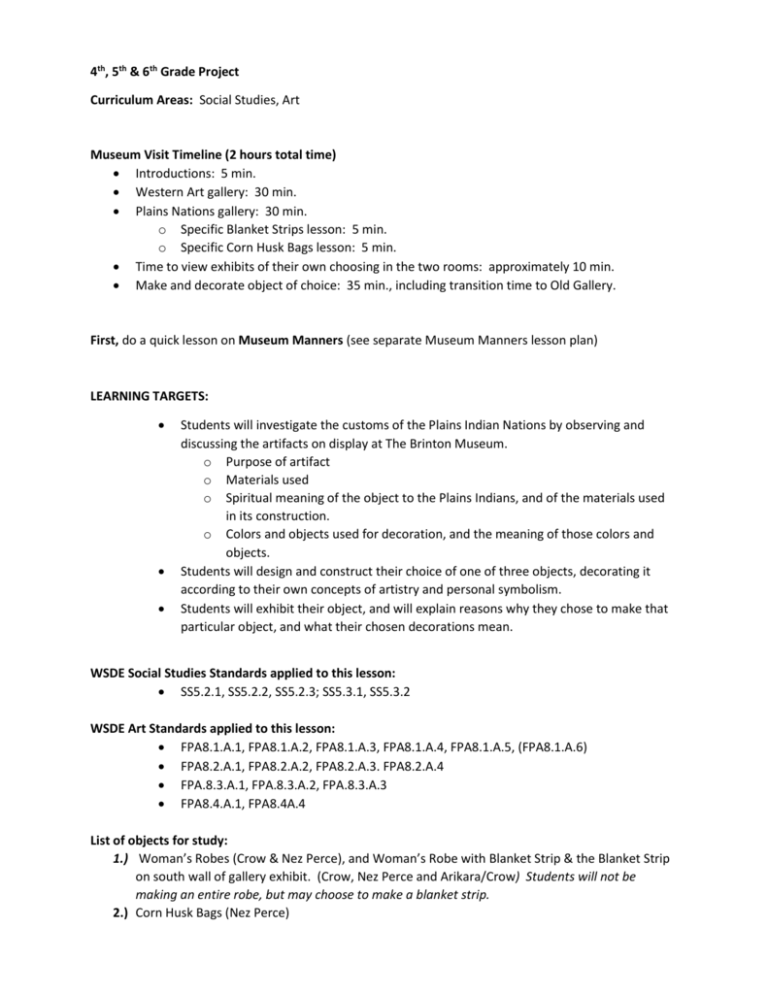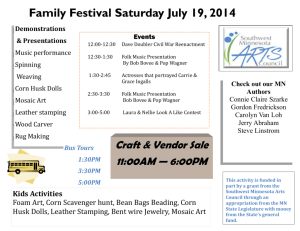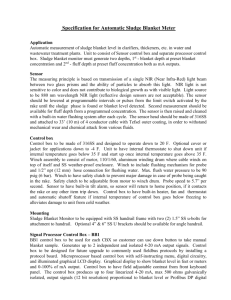
4th, 5th & 6th Grade Project
Curriculum Areas: Social Studies, Art
Museum Visit Timeline (2 hours total time)
Introductions: 5 min.
Western Art gallery: 30 min.
Plains Nations gallery: 30 min.
o Specific Blanket Strips lesson: 5 min.
o Specific Corn Husk Bags lesson: 5 min.
Time to view exhibits of their own choosing in the two rooms: approximately 10 min.
Make and decorate object of choice: 35 min., including transition time to Old Gallery.
First, do a quick lesson on Museum Manners (see separate Museum Manners lesson plan)
LEARNING TARGETS:
Students will investigate the customs of the Plains Indian Nations by observing and
discussing the artifacts on display at The Brinton Museum.
o Purpose of artifact
o Materials used
o Spiritual meaning of the object to the Plains Indians, and of the materials used
in its construction.
o Colors and objects used for decoration, and the meaning of those colors and
objects.
Students will design and construct their choice of one of three objects, decorating it
according to their own concepts of artistry and personal symbolism.
Students will exhibit their object, and will explain reasons why they chose to make that
particular object, and what their chosen decorations mean.
WSDE Social Studies Standards applied to this lesson:
SS5.2.1, SS5.2.2, SS5.2.3; SS5.3.1, SS5.3.2
WSDE Art Standards applied to this lesson:
FPA8.1.A.1, FPA8.1.A.2, FPA8.1.A.3, FPA8.1.A.4, FPA8.1.A.5, (FPA8.1.A.6)
FPA8.2.A.1, FPA8.2.A.2, FPA8.2.A.3. FPA8.2.A.4
FPA.8.3.A.1, FPA.8.3.A.2, FPA.8.3.A.3
FPA8.4.A.1, FPA8.4A.4
List of objects for study:
1.) Woman’s Robes (Crow & Nez Perce), and Woman’s Robe with Blanket Strip & the Blanket Strip
on south wall of gallery exhibit. (Crow, Nez Perce and Arikara/Crow) Students will not be
making an entire robe, but may choose to make a blanket strip.
2.) Corn Husk Bags (Nez Perce)
Introduction: What does the exhibit “To Honor the Plains Nations” tell us about the people who made
and used these objects? What were their lives like? What were their own personal values like?
WOMAN’S ROBE AND BLANKET STRIPS:
Have you ever been cold? Have you ever been lonesome? Wrapping up in a blanket or a robe is
a good way to get warm and cozy. That is exactly what the women and girls of the Crow tribe did. They
would wrap up in a beautiful robe made of buffalo or elk skin, decorated with colorful beads. Not only
were they warm while wearing the robe, they were also wrapped up in the love of their tribe.
Elk or buffalo hides were tanned, then decorated with colorful beadwork, using symbolic
patterns. Hides that were especially large were first cut in half, then sewn back together. In order to
cover the seam on those hides, blanket strips were made and decorated, then sewn onto the robes, in a
combination of art and utility. Sometimes a beaded strip was created, and sewn onto a blanket just to
make it more beautiful. Plains Indians traded across a wide area—the Woodland/Crow blanket with
beaded blanket strip on the south wall came from one of the Great Lakes tribes and was traded to the
Crow tribe.
Meaning and symbolism of the beadwork: “the beaded stripes on this [bridal] robe are symbols
representing the flow of power in the Universe—to the north, south, east and west; above and below.
The butterfly, with its beauty and delicate movements, symbolizes femininity, speed and flight.
Apsaalooke (Crow) Woman’s Robe. Tanned elk hide and glass beads, ca. 1900. TBM.2014.1.107
Meaning and spiritual symbolism of the robe itself: all the women of the tribe were keeping the
young girl or woman warm with the love they put into each stitch of the beadwork. Blue, red and yellow
evoke the colors of the sky and the summer landscape, reflecting the beauty of the lands given to them
by the Creator. “Women’s robes reflect the desire to envelop a woman in both beauty and sacred
power. Starting when she was first able to walk, through the years of young womanhood, and into the
years of marriage, the fullness of the powers given to her as Woman transfigured all aspects of her life.”
(Katie Belton, Gallery Notes on THPN Display, 2015).
Blanket Strips at The Brinton Museum:
1.) Nez Perce Robe with Blanket Strip, on west wall of gallery, ca. 1900.
a. Elk hide and glass beads.
b. Buffalo hides were generally split in half to tan and then stitched back together to
create the robe. Robe strips were a beautiful and practical means to cover the seam.
The strip itself represents the spine of a buffalo, with the circle on the left representing
the head. The red triangle below the strip is the horse symbol, with two ears and a
bridle at the tip.
c. Edith and Goelet Gallatin Collection. TBM.2014.1.108
2.) Woodland Appliquè Blanket with Crow beaded Blanket Strip, early 20th century.
a. Apsáalooke (Crow) Blanket Strip on Prairie Ribbon Applique Blanket
b. Wool, silk, hide, glass and metallic beads, bells and metal discs.
c. Buffalo robes were generally split down the middle for tanning purposes, then stitched
back together. In the older robes, a quilled strip covered the seam, bringing beauty to
the stitched area. In the mid-19th century, beaded strips gained in popularity, and were
attached to both robes and trade cloth blankets. Here, a beaded strip has been applied
to a ribbon applique blanket [obtained by trade] from one of the Great Lakes tribes.
d. Edith and Goelet Gallatin Collection. TBM.2014.1.30
3.) Quill Blanket strip, Arikara [Sahnish] gift to Crow, ca. 1900.
a. Deer hide, porcupine quills, dye and tin cones.
b. Edith and Goelet Gallatin Collection. TBM.2014.1.28
Materials needed for Student Project—Blanket Strips: Construction paper, or other stiff materials
(scraps of mat boards?), rulers or possibly yard sticks, markers, crayons, other decorative materials,
including found objects. (Students will not be making an entire robe.)
Evaluation of completed Blanket Strips
Each blanket strip should have:
At least two contrasting colors
Either geometric or organic shapes, or a mixture of both
An even balance of shapes added along the length of the strip
Shapes should be decorated and not left plain.
Be at least 3 feet long, and at least 2 inches wide, although some decorations can be up to 4.5
inches wide.
The addition of found objects is optional, but not necessary.
Have students write a paragraph explaining their design choices for their Blanket Strip:
Students should explain the original purpose of a blanket or robe. They should specify the width
and length of their Blanket Strip, and explain why the length and width of a Blanket Strip was important
to the Plains Indians. Students should explain their color choice(s) and the difference between
geometric and organic designs. Students should explain the concept of a balanced design, and explain
the reason for attaching found objects to their Blanket Strip, if they chose to use them.
CORN HUSK BAGS:
How do you store food at home? Perishable items go in the refrigerator, less perishable food is
often kept in bags or cartons. A corn husk bag was used by some Plains Indians to store food that would
not spoil easily, such as root crops. They are tightly woven from dried corn husks, decorated on both
sides with colorful geometric patterns, and could be sewn shut at the tops.
These are reservation-era bags. The Nez Perce could not grow corn or raise sheep during the
days when they were nomadic. It also takes time to decorate the bags with the geometric figures, and
the people had more time to do this when there lived a more settled life on the reservation.
Nez Perce means “pierced nose,” a name given to them by early-day French fur trappers.
In the early 19th century, about the time of the Lewis & Clark expedition, the Nez Perce lived in presentday Oregon, Washington and Idaho. The Nez Perce reservation today is located in north central Idaho.
They were a semi-nomadic people, meaning that they constructed permanent earth-houses that
they would return to, after being away on food-gathering and trading trips. When they were on these
trips, they would live in tipis, which were much more portable. By the time the Americans encountered
the Nez Perce tribe, they had acquired horses, which enabled them to range over a much greater
territory to find food and game animals, and trade with other tribes.
Since they were semi-nomadic, how did they get the corn and wool to make these corn-husk
bags? After they encountered Europeans, they were taught to grow crops and tend to livestock. The
corn husk bags here at the museum date from the reservation era in the early 20th century, so they
probably grew the corn to make these bags.
In art, the use of straight lines and angles is called a geometric design. If the design uses circles
and curved lines, it is called organic. It would have been difficult to weave smooth lines into the bags, so
a geometric design was easier, as well as pleasing to the eye. Such geometric designs are found in the
art of many plains and plateau cultures, and reflects an exchange of ideas between tribes who met to
trade, and even to wage war.
Corn Husk Bags at The Brinton Museum:
Corn husk and dye (3 of them), Nez Perce, early 20th century:
o Edith and Goelet Gallatin Collection. TBM.2014.1.68
o Edith and Goelet Gallatin Collection. TBM.2014.1.69
o Edith and Goelet Gallatin Collection. TBM.2014.1.70
2. Corn husk, dye and wool (1), Nez Perce, early 20th century:
o Bradford Brinton Memorial Collection. BBM-T.1254
1.
Made by weaving together dried corn husks, these bags were used to store edible roots, such as
camas, which are similar in taste to pearl onions. The Crow and Nez Perce were close friends and
neighbors across the Rocky Mountain range, regularly trading and interchanging designs. They were
given to the museum by members of the Apsaalooke (Crow) tribe.
Materials needed for Student Project—Corn Husk Bags: Brown paper bags, such as those from the
Museum Gift Shop, or grocery store. Rulers, markers, colored pencils, crayons, and other decorative
items such as glitter, sequins, etc.
Rubric for Student Corn Husk Bags
4 (advanced)
3 (proficient)
2 (basic)
1 (below basic)
Complex geometric designs,
drawn using a ruler, no
organic shapes present,
decorated on both sides.
Unexceptional geometric
design, with no organic
shapes present, decorated
on both sides.
Organic shapes are present,
and no ruler is used. Only
decorated on one side.
Use of 5-6 different colors,
minimum
At least 4 different
geometric shapes are
present.
An exceptional balance of
colors and shapes is present.
At least 4 colors used
Irregular hand-drawn
geometric shapes (without a
ruler) and no organic shapes
present. Only decorated on
one side.
2-3 colors used
3 different geometric shapes
used
2 different geometric shapes
used
1 geometric shape used
A structured balance of
colors and shapes.
Design structure is present,
but not well-balanced.
Designs and colors are
haphazard.
1 color used
Lesson Plan designed by Ariel Downing, Museum Education Department, The Brinton Museum, Big Horn, WY.
Email: adowning@thebrintonmuseum.org. © 2015 TBM All rights reserved








